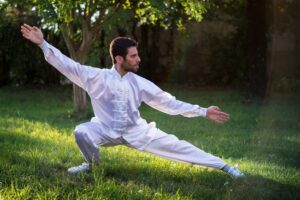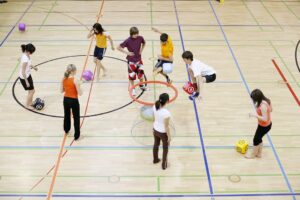We’re delighted you joined Part 2 of Diabetes Exercises. We’ll continue exploring diabetic-specific activities in this section. Regular exercise improves blood sugar, increases insulin sensitivity, improves cardiovascular health, and makes us better.
The Diabetes Exercises series aims to provide readers with a thorough understanding of various exercises and Exercise Routines for People with Diabetes these exercises such as aerobic workouts, weight training, flexibility exercises, and more. Whether you were just diagnosed with diabetes or have been managing it for years, incorporating these workouts into your regimen will improve your health and quality of life. So let’s get started and discover how exercise can assist with diabetes.
Resistance training and weightlifting represent two types of strength training exercises that are going to assist you develop lean muscle mass while simultaneously enhancing insulin sensitivity and speeding up your metabolism. These Diabetes Exercises are key muscle group activities that should be undertaken at least twice a week.
Improving one’s level of flexibility, balance, and range of motion, these activities are beneficial to your overall mobility and can help you prevent catastrophes.
Before commencing any Diabetes Exercises program, diabetics should contact their healthcare professionals, especially if they have underlying health issues or complications. Personal recommendations can be made by the healthcare professional based on the individual’s fitness level, medical history, and specific needs.
Consistent Diabetes Exercises and physical activity ought to be incorporated into one’s everyday routine to successfully cope with diabetes. Finding Diabetes Exercises or activities that are both pleasurable and sustainable is essential for long-term adherence. Individuals with diabetes can improve glucose control, fitness, and overall standard of life by receiving sufficient Assistance and a comprehensive exercise strategy.
Is diabetes exercises mandatory?
Yes, diabetes exercises are very mandatory for every diabetic person.
1 Aerobic activity helps to regulate blood glucose levels by enhancing glucose tolerance and stimulating glucose absorption by muscles.
2 Regular vigorous exercise minimizes the risk of cardiovascular diseases, lowers the risk of stroke, and boosts cholesterol levels.
3 Physical activity enables reducing weight by burning calories and creating lean muscle.
Exercise enhances the body’s reaction to insulin, allowing for more substantial glucose absorption and diminishing levels of insulin resistance. Regular physical activity, such as diabetes exercises, is critical to effectively managing this condition. These (diabetes exercises) specific exercises are designed to meet the specific needs of diabetics, providing a comprehensive approach to blood sugar management and overall health.
Diabetes exercises are remarkable for their adaptability. Whether one is newly diagnosed or has been living with diabetes for years, these exercises can be tailored to individual needs and goals.
The Critical Role of diabetes exercises for Diabetic Persons:
Physical activity increases energy levels, lowers weariness, and promotes general vitality and well-being.
Some of the diabetes exercises are:
Swimming:

1. Swimming is a low-impact activity that is soft on the joints, making it appropriate for those with diabetes who may have joint difficulties or limited mobility.
2. Cardiovascular health: Swimming is a great aerobic exercise that improves cardiovascular fitness, lowers blood pressure, and lowers the risk of heart disease, a common diabetic consequence.
3. Swimming utilizes several muscle groups, offering a full-body workout that improves strength, endurance, and flexibility.
Yoga:

1. Stress reduction: Yoga involves breathing techniques, meditation, and gentle movements that promote relaxation, stress reduction, and overall mental well-being.
2. Increased flexibility and balance: Yoga poses and stretches help to develop flexibility, range of motion, balance, and stability, all of which are important for avoiding falls and accidents.
3. Blood sugar control: Gentle stretches and restorative poses, for example, may help manage blood sugar levels and enhance insulin sensitivity.
4. Mind-body connection: Yoga promotes mindfulness and body awareness, allowing people with diabetes to better comprehend their bodily feelings and manage their health.
5. Reduced inflammation: Some research suggests that yoga has anti-inflammatory properties, which may be beneficial for diabetics who experience chronic inflammation.
Tai Chi:

1. Balance and coordination: Tai Chi involves slow, controlled movements and shifting of body weight, improving balance, coordination, and proprioception. This can help prevent falls, a common concern for individuals with diabetes.
2. Stress reduction: Tai Chi incorporates deep breathing and relaxation techniques, promoting a sense of calm and reducing stress levels.
3. Improved cardiovascular health: Regular practice of Tai Chi can enhance cardiovascular fitness, lower blood pressure, and improve circulation.
4. Joint mobility: The gentle movements of Tai Chi help improve joint flexibility and range of motion, reducing the risk of stiffness and joint problems.
5. Mind-body integration: Tai Chi focuses on the connection between the mind and body, promoting mindfulness, mental clarity, and overall well-being.
Pilates:

1. Core strength: Pilates exercises emphasize core muscles, which aid in the improvement of stability, posture, and general strength.
2. Muscle tone and flexibility: Pilates movements target both major and small muscle groups, increasing flexibility and conditioning the body.
3. Better posture: Pilates workouts emphasize optimal alignment and body awareness, which can assist diabetics in maintaining good posture and resolving muscle imbalances.
4. Mindful movement: Pilates combines breathing methods as well as focus and concentration, resulting in a mindful exercise experience that can reduce stress and promote mental well-being.
5. Damage prevention: Pilates exercises emphasize regulated movements and perfect form, which aid in the strengthening of muscles, the protection of joints, and the reduction of the risk of damage during other activities.
Surya Namaskar (Sun Salutation):

1. Full-body workout: Surya Namaskar is a sequence of yoga postures that provide a complete body workout, engaging multiple muscle groups and promoting strength, flexibility, and cardiovascular endurance.
2. Improved blood circulation: The dynamic movements of Surya Namaskar help stimulate blood flow and oxygen delivery throughout the body, promoting better circulation and nutrient absorption.
3. Stress reduction: Surya Namaskar incorporates rhythmic breathing and flowing movements, creating a meditative and calming effect that reduces stress and anxiety.
4. Increased energy levels: The combination of stretching, strengthening, and controlled breathing in Surya Namaskar can invigorate the body and increase energy levels.
5. Mind-body connection: Surya Namaskar focuses on synchronizing breath with movement, enhancing body awareness, and fostering a deeper connection between the mind, body, and breath.
Team Sports:

1. Social interaction: Participating in team sports allows for social connection, camaraderie, and support, which can lead to improved mental well-being and general motivation to exercise regularly.
2. Increased cardiovascular fitness: Many team sports, such as basketball, soccer, or volleyball, include constant movement, which can enhance cardiovascular health, boost endurance, and lessen the risk of heart disease.
3. Improved coordination and agility: Team sports frequently require fast movements, team coordination, and agility, which can improve balance, reflexes, and overall motor abilities.
4. Mental stimulation: Team sports require strategic thinking, decision-making, and the ability to adapt to unexpected events, which provides mental stimulation and improves cognitive performance.
5. Fun and motivation: Participating in team sports makes exercising more enjoyable.
Aerobic:

1. Aerobic cardio sessions, such as brisk walking, jogging, or cycling, increase heart rate and breathing rate, strengthening the heart muscle and expanding overall cardiovascular health.
2. Dietary control: Aerobic activities assist the reduction of blood glucose by increasing insulin sensitivity and stimulating glucose uptake by muscles, which aids in diabetes blood sugar management.
3. Weight control: Regular aerobic exercise burns calories, promotes weight loss or maintenance, and reduces body fat, all of which can aid with diabetes management and reduction of the risk of complications.
4. Increased energy levels: Aerobic activity stimulates the release of endorphins, the body’s natural feel-good hormones, resulting in increased optimism and joy.
5. Improved lung function: Aerobic exercises emphasize better lung function and increased oxygen intake, thereby aiding overall respiratory health.
Read More: Tips to Manage Diabetes and Prevent Other Diseases
Conclusion
The realm of diabetes exercises covers an extensive array of activities, designed to suit diverse fitness levels and personal inclinations. The choices span from invigorating walks and dynamic cycling sessions to the serene practice of yoga and empowering strength training. Integrating these purposeful exercises into your everyday regimen holds the potential to amplify insulin sensitivity, facilitate weight loss, and elevate cardiovascular well-being. Additionally, the continual commitment to partake in these diabetes exercises can play a pivotal role in diminishing stress, offering an extra advantage to individuals treading the intricate path of diabetes management.
Finally, diabetes exercises are an important part of a comprehensive diabetes management plan. They encourage people to take an active role in their health journey, fostering discipline, determination, and positive outcomes. Individuals can potentially reduce the risk of complications, improve their quality of life, and cultivate a strong sense of well-being by embracing a routine of diabetes exercises. Remember, the key is consistency and finding joy in the journey of incorporating these exercises into daily life. So, lace up those sneakers, roll out the yoga mat, or grab those dumbbells – let diabetes exercises be your trusted companions on the path to a healthier and happier you.
FAQ:
Which diabetes exercise can burn sugar?
Aerobic exercises like brisk walking, cycling, and swimming have been shown to effectively burn sugar and improve blood sugar levels in diabetics.
Can exercise control diabetes?
Regular exercise can help control diabetes by increasing insulin sensitivity, lowering blood sugar levels, and improving overall health. Along with proper diet and medical treatment, it is an essential component of diabetes management.
How can we remove sugar from our bodies?
Reducing sugar intake, opting for whole foods, and staying hydrated can aid in naturally lowering sugar levels in the body. Regular exercise, particularly aerobic activities, also help utilize glucose. Consultation with a healthcare professional and maintaining a balanced lifestyle are key to effective sugar management.
What exercises should diabetics person avoid?
Diabetes patients should avoid high-impact exercises such as heavy weightlifting and contact sports. These activities, which involve quick and forceful movements, can result in injuries.
How can anyone lower his blood sugar quickly?
Swiftly reducing blood sugar levels can be achieved through a 15-minute brisk walk, consuming water with a hint of lemon juice, or participating in gentle aerobic activities. Regulating carb intake and opting for fiber-rich foods further supports blood sugar management. Always consult a healthcare expert for guidance.






